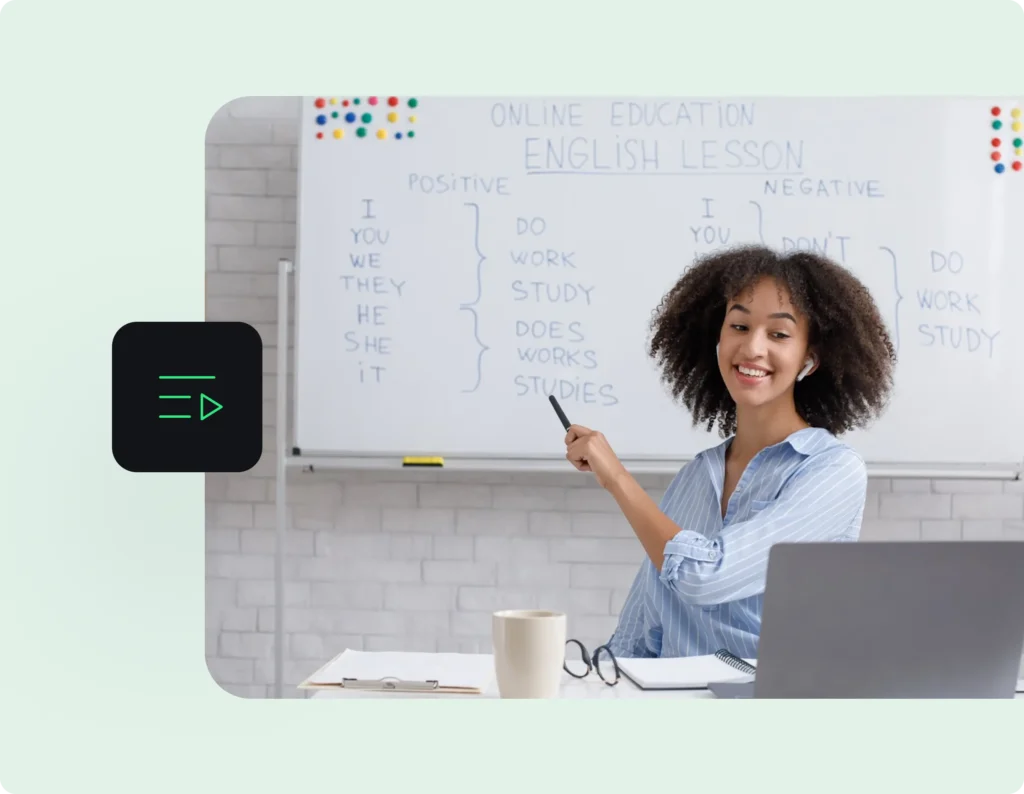- Education
Using Video For Asynchronous Learning To Support Student Needs

Higher education has shifted post-pandemic to one of asynchronous learning. The future of learning is evolving in response to the ever-changing world we live in, where remote living is the new norm.
It’s not all sustainable, though – with an increase in video-based courses and lectures, an increase in burnout is also likely to occur. Meanwhile, students are returning to the classroom but still expect to have access to lectures on demand to suit their learning needs.
Universities are exploring how to reduce the fatigue brought on by synchronous video while managing facility finances, students’ needs, and retention. This is where asynchronous video comes in.
Using video for asynchronous communication can enable students to learn in a flexible environment—when and how they want—while also maintaining educational equity.
Acing the Virtual Classroom with Asynchronous Video
Learn how using synchronous and asynchronous video together is the key to success and the top five teaching strategies you can implement today to ace virtual learning.

In this asynchronous learning guide, you will learn
- What is Asynchronous Learning?
- How Asynchronous Video is Used in Learning
- Benefits of Asynchronous Communication
- How Video Capture supports User-Friendly Async Learning
- Best Practices for Asynchronous Communication
- The Future of Asynchronous Learning
What is asynchronous video learning?
Asynchronous video refers to any video that is not live-streamed and can be used for both one-way and two-way communication. It can be accessed multiple times at any time.
So, what’s the difference between asynchronous and synchronous communication? Asynchronous communication does not occur in real time, and there is no expectation of an immediate response. On the other hand, synchronous communication can be spontaneous or scheduled and happens live between two or more people at the same moment.
Viewers retain 95% of a message when they watch it in a video compared to 10% when reading it in text.
Types of asynchronous and synchronous communication
Types of asynchronous communication include:
- Sending a video in an email
- Training, demo, or how-to videos
- Live stream recordings
- Video recordings
- Webinars
- Recorded lectures
- Project management tools
- Forum or video comments
Types of synchronous communication include:
- In-person meetings
- Phone or video calls
- Live webinars or lectures
- Live training sessions
- Asking a teacher a question in class
How asynchronous video is used in learning
In education, asynchronous learning allows students to access or interact with instructional materials online at any time. This typically occurs in the form of on-demand videos or the recording of a live lecture that can be viewed at a later time.
In addition, asynchronous video provides the opportunity for teachers to give their students detailed feedback on video tasks and assessments or enable students to provide progress reports.
Examples of asynchronous learning in the classroom
Asynchronous learning can include:
- Student and teacher introduction videos
- Watching pre-recorded lectures
- Pre-lecture assignments to increase student exposure, understanding, and interest in a topic
- Flipping the classroom
- Providing additional resources to support core learning materials
- Providing detailed feedback on assignments
- Visually demonstrating complex topics that can be difficult to describe in text
Benefits of asynchronous communication
Whether asynchronous video is being used in the classroom or the workplace, there are a number of reasons why educators are turning to this mode of communication. The key benefits of asynchronous learning are that it:
- Counteracts video conferencing fatigue
- It can often be shared across multiple platforms
- Addresses student learning gaps by enabling students to comment on the video itself in Panopto
- Provides the flexibility for people to learn when they want (including across different time zones), according to their own schedule
- Gives students the opportunity to learn at their own pace, to stop, pause, and speed up recorded videos so they can absorb the information
- Allows those creating asynchronous videos to present in a diverse range of settings to contextually answer a specific question or approach a certain topic in the right surroundings
- Enables students to record video meetings, archive them, and view at a later date. This could work well for group assignments, team meetings, and faculty announcements
- Supports accessible learning through captioning features, variable speed playback, offline viewing for those with limited internet access, screen reader support, and a visually accessible user interface
- Reduces the number of learning materials that faculty staff need to create through reusable video assets that can be added to a searchable library
“Even before COVID-19, around half of the students in the classes I teach review face-to-face lectures they attended at a later date. A survey of students found that they like how Panopto allows them to watch content on demand, whenever they please, and to repeatedly re-watch lessons. I believe on-demand streaming is going to be an indispensable part of education in the future.”
Mitsuishi Takashi, Associate Professor, Tohoku University
How video capture supports user-friendly async learning
Lecture capture is a vital resource for both students and teachers. Not only does it improve student performance and experience, staff have also reported that watching their lecture recording back had a positive impact on their teaching.
How to record an asynchronous video
Panopto is the ideal tool to use for recording asynchronous videos, and it also offers a powerful cloud-based editor that makes it easy to achieve the most common editing tasks right from your browser.
Here are the steps on how to record an asynchronous video:
Step 1: Open Panopto’s in-browser online video recorder.
Step 2: To adjust the recording settings click on the button in the bottom right hand corner of the recorder. This will allow you to adjust the video definition, layout, background, and camera options.
Step 3: In the screens and apps menu at the top right corner of the screen, you can choose which screen or application you want to share. This is especially helpful when you want to record presentations in an app such as PowerPoint.
Step 4: Click on the red button to begin the recording.
Step 5: To end the recording click on the red button.
Step 6: Ending the recording will bring up sharing options for the video including send to Panopto, send to YouTube, or send to classroom. There is also an option to save the video to your computer by clicking the download button on the right side of the screen.
83% of teachers say their teaching experience is enhanced with video use.
Best synchronous and asynchronous tools to use together
At Panopto we focus on producing a product that can integrate existing video technology with a growing number of systems, so that you can easily connect your video platform to tools you already use.
Panopto merges with learning management systems (such as Canvas, Moodle, and Blackboard) so you can record, view, search, and manage your videos in your LMS, ensuring classroom recordings can be found right where people expect them.
Our integration with leading video conferencing platforms means that you can automate typically time-consuming and complicated video workflows.
Panopto’s built-in Zoom integration creates an end-to-end video solution you can use to capture lectures or discussions, then automatically upload, search, and share in Panopto’s library. Meanwhile, with our Microsoft Teams integration, users can securely search, play, share, and manage their Panopto videos and meeting recordings without leaving Teams.
Our integrations create a unified ecosystem where asynchronous and synchronous communication can be combined to increase student, teacher, and employee productivity and deliver virtual learning at scale.
We also accommodate a range of devices for lectures to be viewed on. Our technology may be advanced, but it is created with all users in mind, resulting in a product that is easy-to-use for everyone.
“The Zoom + Panopto integration was a critical element that facilitated the real-time interaction and the asynchronous access to the instructional material in our LMS.”
Dan Skendzel, Executive Director, ND Studios and Teaching and Learning Technologies, University of Notre Dame.
Best practices for asynchronous communication
To ensure that you are maximizing the way you communicate asynchronously, it is important to keep in mind certain best practices.
- Be clear and detailed when recording a video to ensure that all necessary information is being conveyed.
- Use the right tools:
- Slack, which can used by students and teachers to replace email communication, enabling a responsive sharing and discussing of information
- Project management tools such as Monday, which can be used by students to help manage their classes, assignments, grades, events, and social activities all in one place
- Video recording tools such as Panopto
- Google drive
- Visual collaboration tools such as Miro, which can be used by students to present projects, brainstorm ideas, get feedback on concepts, document progress, and collaborate remotely
- Track student progress and engagement using analytics tools
- Ensure accessibility practices are integrated into video conferencing tools and LMSs. For example, ensure captioning and screen reader capabilities are turned on
The future of asynchronous learning
The future of learning is no longer static. Learning and teaching methods must be able to keep up with the changing needs of students, where flexibility and accessibility are at the forefront.
An innovative and thoughtful asynchronous video learning program enables students to learn at their own pace – and Panopto provides the tool to support this endeavor. When engaging asynchronous video presentations are combined with mindful synchronous communication, both instructors and students can discover an empowering learning experience that uses video to expand the boundaries of the traditional classroom.
Schedule a Panopto demo
Our team will contact you promptly to answer questions and schedule you for a demonstration and a free trial of our video platform.



